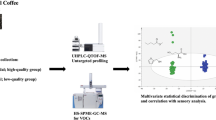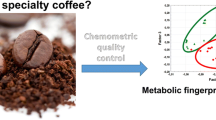Abstract
Coffee is one of the most highly valued, consumed and comercialized foods in the world. Due to its considerable importance, it has become the target of numerous adulterations. Detecting a possible adulteration and the presence of additional adulterants in coffee has become an issue of great concern mainly because the compounds used as adulterants exhibit physical features very similar to ground roasted coffee. Aiming to overcome these difficulties, this work reports the development and application of a relatively faster, highly effective and reliable method for the detection and identification of adulterations in roasted coffee through the analysis of the composition of the volatile fraction in the presence of adulterants such as rice, corn, soybeans and barley. The proposed method was based on gas chromatography coupled with mass spectrometry (GC–MS) and chemometric tools. The application of the method led to the exclusive identification of many compounds in the volatile fraction of the adulterants investigated. The adulterants, despite having compounds similar to coffee, differed in terms of their volatile profiles, and consisted mainly of hydrocarbons, aldehydes, esters and carboxylic acids. Among all the compounds identified, five compounds were found to be the main determinants of adulteration: 2-furanmethanol-acetate, 2-methoxy-4-vinylphenol, 5-methyl-2-furancarboxaldehyde, 2-furanmethanol and glycerol-1,2-diacetate.




Similar content being viewed by others
References
Toci AT, Farah A, Pezza HR, Pezza L (2016) Coffee adulteration: more than two decades of research. Crit Rev Anal Chem 46:83–92. https://doi.org/10.1080/10408347.2014.966185
Ribeiro MVM, Boralle N, Pezza HR, Pezza L, Toci AT (2017) Authenticity of roasted coffee using 1HNMR spectroscopy. J Food Compos Anal 57:24–30. https://doi.org/10.1016/j.jfca.2016.12.004
Bandeira RDCC, Toci AT, Trugo LC, Farah A (2009) Volatile composition of intrinsic defective coffee beans by GC/MS-headspace. Quím Nova 32:309–314. https://doi.org/10.1590/S0100-40422009000200008
Oliveira RC, Oliveira LS, Franca AS, Augusti R (2009) Evaluation of the potential of SPME-GC-MS and chemometrics to detect adulteration of ground roasted coffee with roasted barley. J Food Compos Anal 22:257–261. https://doi.org/10.1016/j.jfca.2008.10.015
Toci AT, Farah A (2008) Volatile compounds as potential defective coffee beans’ markers. Food Chem 108:1133–1141. https://doi.org/10.1016/j.foodchem.2007.11.064
Toledo PRAB, Pezza L, Pezza HR, Toci AT (2016) Relationship between the different aspects related to coffee quality and their volatile compounds. Compr Rev Food Sc Food Saf 15:705–719. https://doi.org/10.1111/1541-4337.12205
Flament I (2002) Coffee flavor chemistry. John Wiley & Sons, Chichester
Milani MI, Rossini EL, Catelani TA, Pezza L, Toci AT, Pezza HR (2020) Authentication of roasted and ground coffee samples containing multiple adulterants using NMR and a chemometric approach. Food Control 112:107104. https://doi.org/10.1016/j.foodcont.2020.107104
Food and Agriculture Organization of the United Nations, World Trade Organization (2017) Trade and food standards. http://www.fao.org/3/a-i7407e.pdf. Accessed 06 Feb 2024.
Tavares KM, Pereira RGFA, Nunes CA, Pinheiro ACM, Rodarte MP, Guerreiro MC (2012) Mid-infrared spectroscopy and sensory analysis applied to detection of adulteration in roasted coffee by addition of coffee husks. Quím Nova 35:1164–1168. https://doi.org/10.1590/S0100-40422012000600018
Pauli ED, Barbieri F, Garcia PS, Madeira TB, Acquaro VR, Scarminio IS, Camara CAP, Nixdorf SL (2014) Detection of ground roasted coffee adulteration with roasted soybean and wheat. Food Res Int 61:112–119. https://doi.org/10.1016/j.foodres.2014.02.032
Winkler-Moser JK, Singh M, Rennick KA, Bakota EL, Jham G, Liu SX, Vaughn SF (2015) Detection of corn adulteration in Brazilian coffee (Coffea arabica) by tocopherol profiling and near-infrared (NIR) spectroscopy. J Agric Food Chem 63:10662–10668. https://doi.org/10.1021/acs.jafc.5b04777
Ministry of Agriculture, Livestock and Supply (2010) Normative Instruction MAPA N° 16, May 24, 2010., Brasília. https://app.sogi.com.br/Manager/texto/arquivo/exibir/arquivo?eyJ0eXAiOiJKV1QiLCJhbGciOiJIUzI1NiJ9AFFIjAvNTAwNTAvU0dfUmVxdWlzaXRvX0xlZ2FsX1RleHRvLzAvMC9JTlNUUlXDh8ODTyBOT1JNQVRJVkEgTUFQQSBOwrogMTYsIERFIDI0LTA1LTIwMTAuZG9jLzAvMCIAFFhwEsyUg-kaMr-3F492-fOoRRIHAVUz3yRQ8P4GTAeww. Accessed 06 Feb 2024.
Toledo BR, Hantao LW, Ho TD, Augusto F, Anderson JL (2014) A chemometric approach toward the detection and quantification of coffee adulteration by solid-phase microextraction using polymeric ionic liquid sorbent coatings. J Chromatogr A 1346:1–7. https://doi.org/10.1016/j.chroma.2014.04.035
Couto CC, Mamede MGNA, Galdeano CM, Oliveira EMM, Freitas-Silva O (2018) Development of coffea Arabica and c. canephora blends. Curr Nutr Food Sci 14:432–441. https://doi.org/10.2174/1573401313666170622094707
Tomasi G, Savorani F, Engelsen SB (2011) Icoshift: an effective tool for the alignment of chromatographic data. J Chromatogr A 1218:7832–7840. https://doi.org/10.1016/j.chroma.2011.08.086
Chemometrics Research (2023) Icoshift - an ultra rapid and versatile tool for the alignment of spectral datasets. http://www.models.life.ku.dk/icoshift. Accessed 06 Feb 2024.
Svante W, Esbensen K, Geladi P (1987) Principal component analysis. Chemometr Intell Lab Syst 2:37–52. https://doi.org/10.1016/0169-7439(87)80084-9
Bro R, Smilde AK (2014) Principal component analysis. Anal Met 6:2812–2831. https://doi.org/10.1039/C3AY41907J
Rodionova O, Kucheryavskiy S, Pomerantsev A (2021) Efficient tools for principal component analysis of complex data–a tutorial. Chemometr Intell Lab Syst 213:104304. https://doi.org/10.1016/j.chemolab.2021.104304
Valderrama L, Demczuk B Jr, Valderrama P, Carasek E (2022) An eco-friendly proposal by integrating chromatographic fingerprinting and multivariate control chart in a non-target analysis to evaluate grape juices from different farming practices. J Braz Chem Soc 33:401–405. https://doi.org/10.21577/0103-5053.20210153
Toci AT, Farah A (2014) Volatile fingerprint of Brazilian defective coffee seeds: corroboration of potential marker compounds and identification of new low quality indicators. Food Chem 153:298–314. https://doi.org/10.1016/j.foodchem.2013.12.040
Vieira CR, Cabral LC, De Paula ACO (1999) Proximate composition and amino acid, fatty acid and mineral contents of six soybean cultivars for human consumption. Pesq Agropec Bras 34:1277–1283. https://doi.org/10.1590/S0100-204X1999000700021
Fujita AH, Figueroa MOR (2003) Nutrient profile and beta-glucans content in cereal seeds and foodstuffs contain them. Food Sci and Techn 23:116–120. https://doi.org/10.1590/S0101-20612003000200003
Walter M, Marchezan E, Avila LA (2008) Rice: composition and nutritional characteristics. Rural Sci 38:1184–1192. https://doi.org/10.1590/S0103-84782008000400049
Teodoro JTT (2018) Determinação de ferro e composição centesimal de farinhas de trigo e milho, Medianeira. http://repositorio.utfpr.edu.br/jspui/handle/1/13277. Accessed 06 Feb 2024.
Toci AT, Zanoni MVB (2018) In: Grumezescu AM, Holban A M (eds), Natural and artificial flavoring agentes and food dyes, vol. 7. Academic Press.
Acknowledgements
The authors do sincerely acknowledge their indebtedness and gratitude to the Consorcio Café, Rio de Janeiro State Research Foundation (FAPERJ-E-26.201.302/2022, E-26/210.306/2022 and E-26/202.046/2022), the National Council for Scientific and Technological Development (CNPq-311108/2021-0), the Coordenação de Aperfeiçoamento de Pessoal de Nível Superior (CAPES-Finance Code 001) and the Fundação de Amparo à Pesquisa do Estado de São Paulo (FAPESP, process number 2021/12866-9) for the provision of resources and for the financial assistance granted in support of this work.
Author information
Authors and Affiliations
Corresponding authors
Ethics declarations
Conflict of interest
There are no conflicts of interest to declare.
Compliance with ethical requirements
This article does not contain any studies with human or animal subjects.
Additional information
Publisher's Note
Springer Nature remains neutral with regard to jurisdictional claims in published maps and institutional affiliations.
Supplementary Information
Below is the link to the electronic supplementary material.
Rights and permissions
Springer Nature or its licensor (e.g. a society or other partner) holds exclusive rights to this article under a publishing agreement with the author(s) or other rightsholder(s); author self-archiving of the accepted manuscript version of this article is solely governed by the terms of such publishing agreement and applicable law.
About this article
Cite this article
de Souza, J.C., de Carvalho Couto, C., Mamede, A.M.G.N. et al. Using volatile compounds for the identification of coffee adulterants: marker compounds and non-targeted analysis. Eur Food Res Technol (2024). https://doi.org/10.1007/s00217-024-04563-3
Received:
Revised:
Accepted:
Published:
DOI: https://doi.org/10.1007/s00217-024-04563-3




